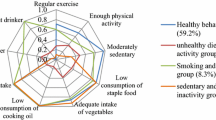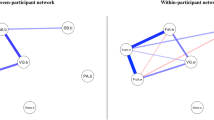Abstract
Background
Examining responders and non-responders to behavioral lifestyle interventions among overweight/obese adults with additional comorbidities may aid in refining and tailoring obesity treatment.
Purpose
The purpose of this study is to demonstrate the use of latent class analysis to identify patterns of response to behavioral lifestyle interventions based on adherence to diet and exercise recommendations.
Method
Repeated measures latent class analysis was applied to two clinical trial datasets, combination of two active interventions in the PREMIER Trial (n = 501) and phase 1 of the Weight Loss Maintenance Trial (WLM; n = 1685), to identify patterns of response to behavioral lifestyle interventions. Treatment response was based on adherence to daily recommendations for fruit/vegetable, fat, saturated fat, sodium, and exercise at baseline and 6 months.
Results
In PREMIER, three distinct latent classes emerged: responders (45.9 %), non-responders (23.6 %), and early adherers (30.5 %). Responders and Early Adherers had greater weight loss at 6 and 18 months and were more likely to meet behavioral recommendations at 18 months than Non-responders. For WLM, there were four latent classes: partial responders (16 %), non-responders (40 %), early adherers (2 %), and fruit/veggie only responders (41 %). Non-responders in WLM had significantly less weight loss at 6 months compared to that of the other three latent classes.
Conclusion
Latent class analysis is a useful method to apply to clinical trial data to identify distinct patterns of response to behavioral interventions. Overweight/ obese participants who respond to behavioral lifestyle treatment (i.e., meet behavioral recommendations) have significantly greater weight loss than that of participants who do not make behavioral changes.



Similar content being viewed by others
References
Butryn ML, Webb V, Wadden TA. Behavioral treatment of obesity. Psychiatr Clin North Am. 2011;34(4):841–59.
Wadden TA, Webb VL, Moran CH, Bailer BA. Lifestyle modification for obesity: new developments in diet, physical activity, and behavior therapy. Circulation. 2012;125(9):1157–70.
Kong W, Langlois MF, Kamga-Ngande C, Gagnon C, Brown C, Baillargeon JP. Predictors of success to weight-loss intervention program in individuals at high risk for type 2 diabetes. Diabetes Res Clin Pract. 2010;90(2):147–53.
Teixeira PJ, Going SB, Houtkooper LB, Cussler EC, Metcalfe LL, Blew RM, et al. Pretreatment predictors of attrition and successful weight management in women. Int J Obes Relat Metab Disord. 2004;28(9):1124–33.
Collins LM, Lanza ST. Latent class and latent transition analysis: with applications in the social, behavioral, and health sciences. New Jersey: Wiley; 2010.
Lanza ST, Rhoades BL. Latent class analysis: an alternative perspective on subgroup analysis in prevention and treatment. Prev Sci. 2013;14(2):157–68.
Appel LJ, Champagne CM, Harsha DW, Cooper LS, Obarzanek E, Elmer PJ, et al. Effects of comprehensive lifestyle modification on blood pressure control: main results of the PREMIER clinical trial. JAMA. 2003;289(16):2083–93.
Elmer PJ, Obarzanek E, Vollmer WM, Simons-Morton D, Stevens VJ, Rohm Young D, et al. Effects of comprehensive lifestyle modification on diet, weight, physical fitness, and blood pressure control: 18-month results of a randomized trial. Ann Intern Med. 2006;144(7):485–95.
Svetkey LP, Stevens VJ, Brantley PJ, et al. Comparison of strategies for sustaining weight loss: the Weight Loss Maintenance randomized controlled trial. JAMA. 2008;299(10):1139–48.
Jones LR, Wilson CI, Wadden TA. Lifestyle modification in the treatment of obesity: an educational challenge and opportunity. Clin Pharmacol Ther. 2007;81(5):776–9.
Funk KL, Elmer PJ, Stevens VJ, Harsha DW, Craddick SR, Lin PH, et al. PREMIER—a trial of lifestyle interventions for blood pressure control: intervention design and rationale. Health Promot Pract. 2008;9(3):271–80.
Appel LJ, Moore TJ, Obarzanek E, Vollmer WM, Svetkey LP, Sacks FM, et al. A clinical trial of the effects of dietary patterns on blood pressure. DASH collaborative research group. N Engl J Med. 1997;336(16):1117–24.
Karanja NM, Obarzanek E, Lin PH, McCullough ML, Phillips KM, Swain JF, et al. Descriptive characteristics of the dietary patterns used in the dietary approaches to stop hypertension trial. DASH collaborative research group. J Am Diet Assoc. 1999;99(8 Suppl):S19–27.
Hollis JF, Gullion CM, Stevens VJ, et al. Weight loss during the intensive intervention phase of the Weight Loss Maintenance Trial. Am J Prev Med. 2008;35(2):118–26.
Blair SN, Haskell WL, Po H, Paffenbarger RS, Vranizan KM, Farquhar JW, et al. Assessment of habitual physical activity methodology by a seven-day recall in a community survey and controlled experiments. Am J Epidemiol. 1986;122:794–804.
Sallis JF, Haskell WL, Wood PD, Fortmann SP, Rogers T, Blair SN, et al. Physical activity assessment methodology in the five-city project. Am J Epidemiol. 1985;121(1):91–106.
Harlan LC, Block G. Use of adjustment factors with a brief food frequency questionnaire to obtain nutrient values. Epidemiology. 1990;1(3):224–31.
US Department of Agriculture. The food guide pyramid. Vol Home and Garden Bulletin No. 252. Washington, D.C.: US Department of Agriculture; 1992.
Akaike H. Factor analysis and AIC. Psychometrika. 1987;52:317–32.
Sclove L. Application of model-selection criteria to some problems in multivariate analysis. Psychometrika. 1987;52:333–43.
Nylund KL, Asparouhov T, Muthen B. Deciding on the number of classes in latent class analysis and growth mixture modeling: a Monte Carlo simulation study. Struct Equ Model: Multidiscip J. 2007;14:535–69.
Wang C, Brown CH, Bandeen-Roche K. Residual diagnostics for growth mixture models: examining the impact of a preventive intervention on multiple trajectories of aggressive behavior. J Am Stat Assoc. 2005;100(3):1054–76.
Knowler WC, Barrett-Connor E, Fowler SE, et al. Reduction in the incidence of type 2 diabetes with lifestyle intervention or metformin. N Engl J Med. 2002;346(6):393–403.
Look AHEAD Research Group, Wing RR. Long-term effects of a lifestyle intervention on weight and cardiovascular risk factors in individuals with type 2 diabetes mellitus: four-year results of the Look AHEAD trial. Arch Intern Med. 2010;170(17):1566–75.
World Health Organization. Obesity: preventing and managing the global epidemic. Report of a WHO consultation on obesity, Geneva, June 3–5, 1997. 1998; Publication No. WHO/NUT/NCD/98.1.
Subar AF, Thompson FE, Kipnis V, Midthune D, Hurwitz P, McNutt S, et al. Comparative validation of the Block, Willett, and National Cancer Institute Food Frequency Questionnaires. Am J Epidemiol. 2001;154(12):1089–99.
Sloane R, Clutter Snyder D, Demark-Wahnefried W, Lobach D, Kraus WE. Comparing the 7-day PAR with a triaxial accelerometer for measuring time in exercise. Med Sci Sports Exerc. 2009;41(6):1334–40.
de Vries H, Van’t Riet J, Spigt M, Metsemakers J, van den Akker M, Vermunt JK, et al. Clusters of lifestyle behaviors: results from the Dutch SMILE study. Prev Med. 2008;46(3):203–8.
BeLue R, Lanza ST, Figaro MK. Lifestyle therapy changes and hypercholesterolemia: Identifying risk groups in a community sample of Blacks and Whites. Ethn Dis. 2009;19(2):142–7.
Ogden LG, Stroebele N, Wyatt HR, Catenacci VA, Peters JC, Stuht J, et al. Cluster analysis of the national weight control registry to identify distinct subgroups maintaining successful weight loss. Obesity (Silver Spring). 2012;20(10):2039–47.
Trivedi RB, Ayotte BJ, Thorpe CT, Edelman D, Bosworth HB. Is there a nonadherent subtype of hypertensive patient? A latent class analysis approach. Patient Prefer Adherence. 2010;4:255–62.
Lanza ST, Collins LM. A mixture model of discontinuous development in heavy drinking from ages 18 to 30: the role of college enrollment. J Stud Alcohol. 2006;67(4):552–61.
Espeland MA, Bray GA, Neiberg R, et al. Describing patterns of weight changes using principal components analysis: results from the action for health in diabetes (Look AHEAD) research group. Ann Epidemiol. 2009;19(10):701–10.
Neiberg RH, Wing RR, Bray GA, et al. Patterns of weight change associated with long-term weight change and cardiovascular disease risk factors in the Look AHEAD study. Obesity (Silver Spring). 2012;20(10):2048–56.
Vermunt JK, Magidson J. Latent class cluster analysis. In: Hagenaars JA, McCutcheon AL, eds. Applied latent class analysis. Cambridge University Press:; 2002:89–106.
Fitzpatrick SL, Lai BS, Brancati FL, Golden SH, Hill-Briggs F. Metabolic syndrome risk profiles among African American adolescents: National Health and Nutrition Examination Survey, 2003–2010. Diabetes Care. 2013;36(2):436–42.
Lei H, Nahum-Shani I, Lynch K, Oslin D, Murphy SA. A “SMART” design for building individualized treatment sequences. Annu Rev Clin Psychol. 2012;8:21–48.
Almirall D, Nahum-Shani I, Sherwood NE, Murphy SA. Introduction to SMART designs for the development of adaptive interventions: with application to weight loss research. Translational Behavioral Medicine. Published online: 06 May 2014.
Conflict of Interest
Lawrence Appel, Janelle Coughlin, Arlene Dalcin, and Gerald Jerome have an institutional (Johns Hopkins University) conflict of interest with Healthways, Inc.
Author information
Authors and Affiliations
Corresponding author
Rights and permissions
About this article
Cite this article
Fitzpatrick, S.L., Coughlin, J.W., Appel, L.J. et al. Application of Latent Class Analysis to Identify Behavioral Patterns of Response to Behavioral Lifestyle Interventions in Overweight and Obese Adults. Int.J. Behav. Med. 22, 471–480 (2015). https://doi.org/10.1007/s12529-014-9446-y
Published:
Issue Date:
DOI: https://doi.org/10.1007/s12529-014-9446-y




